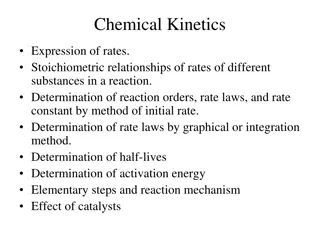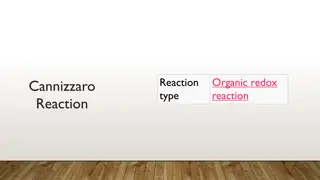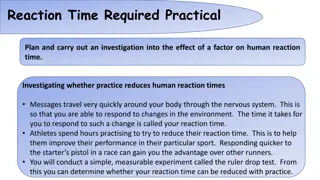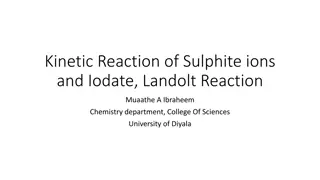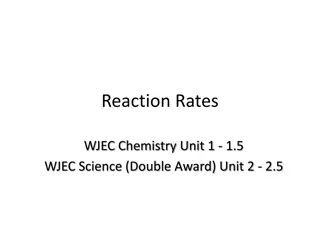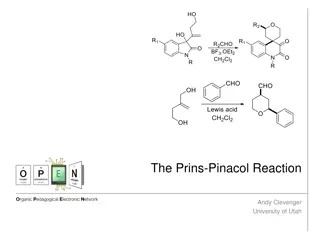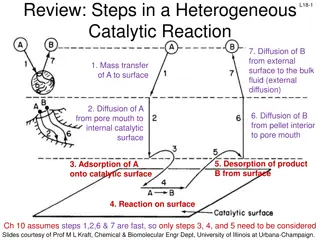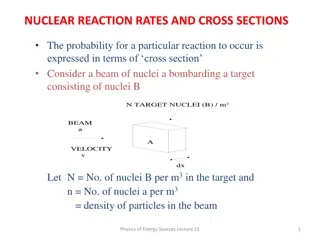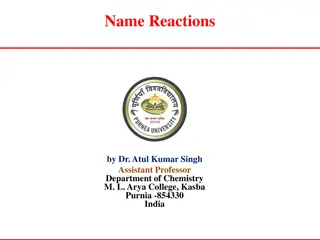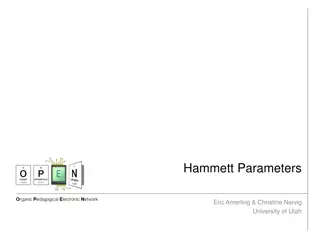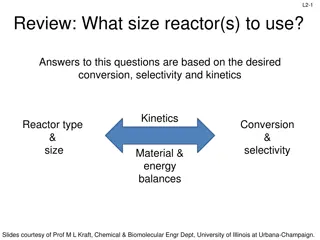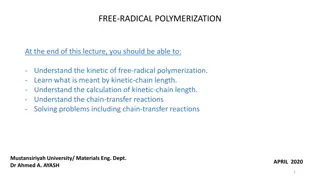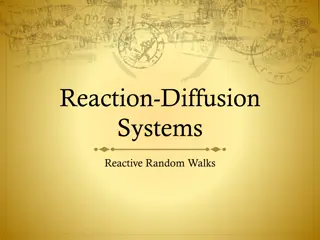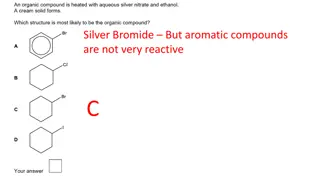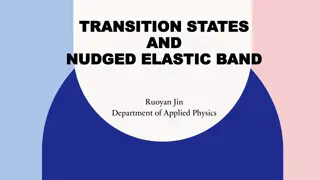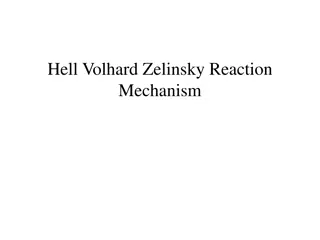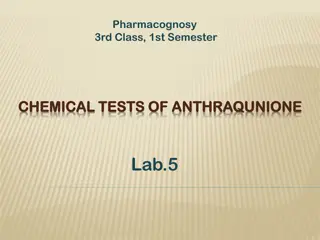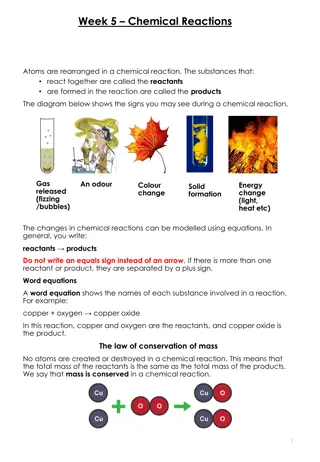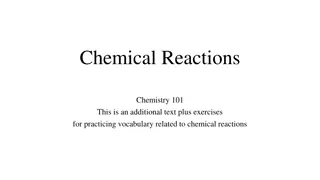Understanding Chemical Kinetics: Reaction Rates and Mechanisms
Chemical kinetics is a branch of chemistry focused on studying reaction rates and mechanisms. Unlike thermodynamics, which deals with feasibility, kinetics explores the speed at which reactions occur. Factors such as temperature, pressure, and catalysts influence reaction rates. Understanding the rate of a reaction involves monitoring changes in reactant or product concentrations over time. Mathematical expressions help quantify these changes and determine reaction rates. Kinetic studies play a crucial role in manipulating reaction rates under different conditions. Real-life examples illustrate how kinetics provides valuable insights into the dynamics of chemical reactions.
Download Presentation

Please find below an Image/Link to download the presentation.
The content on the website is provided AS IS for your information and personal use only. It may not be sold, licensed, or shared on other websites without obtaining consent from the author. Download presentation by click this link. If you encounter any issues during the download, it is possible that the publisher has removed the file from their server.
E N D
Presentation Transcript
Chemical Kinetics The branch of chemistry, which deals with the study of reaction rates and their mechanisms, called chemical kinetics. Thermodynamics tells feasibility of a reaction whereas chemical kinetics tells about the rate of a reaction. For example, thermodynamic data indicate that diamond shall convert to graphite but in reality the conversion rate is so slow that the change is not perceptible at all. only about the
Chemical Kinetics Kinetic studies not only help us to determine the speed or rate of a chemical reaction but also describe the conditions by which the reaction rates can be altered. The factors such temperature, pressure and catalyst affect the rate of a reaction. as concentration,
Rate of a Chemical Reaction The speed of a reaction or the rate of a reaction can be defined as the change in concentration of a reactant or product in unit time. It can be expressed in terms of: (i) the rate of decrease in concentration of any one of the reactants, or (ii) the rate of increase in concentration of any one of the products.
Consider a hypothetical reaction, assuming that the volume of the system remains constant R P One mole of the reactant R produces one mole of the product P. If [R]1 and [P]1 are the concentrations of R and respectively at time t1and [R]2and [P]2 are their concentrations at time t2 then, t = t2 t1 & [R] = [R]2 [R]1 [P] = [P]2 [P]1 The square brackets in the above expressions are used to express molar concentration.
Rate of disappearance of R = Decrease in concentration of R = [R] Time taken t Rate of appearance of P = Increase in concentration of P = + [P] Time taken t Since, [R] is a negative quantity (as concentration of reactants is decreasing), it is multiplied with 1 to make the rate of the reaction a positive quantity.
The Rate of a Chemical Reaction Consider the following chemical reaction - 2 Fe3+(aq) + Sn2+ 2 Fe2+(aq) +Sn4+(aq) [Fe2+] = 0.0010 M [Fe2+] = (0.0010 0) M t = 38.5 s t = 38.5 s [Fe2+] 0.0010 M Rate of formation of Fe2+= = = 2.6x10-5 M s- t 38.5 s
2 Fe3+(aq) + Sn2+ 2 Fe2+(aq) + Sn4+(aq) [Sn4+] t [Fe3+] t [Fe2+] t 1 = - 1 = 2 2
General Rate of Reaction a A + b B c C + d D Rate of reaction = rate of disappearance of reactants [B] t [A] t 1 b 1 a = - = - Eqn.1 = rate of appearance of products [D] t [C] t 1 d 1 c = = Eqn.2 [D] [C] 1 d 1 c [B] t [A] t 1 b 1 a = = Eqn.3 - = - or t t
Average rate depends upon the change in conc. of reactants or products and the time taken for that change to occur. Equations 1-3 represent the average rate of a reaction,rav. The rate of reaction at a particular moment of time is called as the instantaneous rate, rins. It is obtained when we consider the average rate at the smallest time interval say dt ( i.e. when t approaches zero).
Mathematically for an infinitesimally small time interval, dt, instantaneous rate is given by rav = [R ] = [P ] t t As t 0 or rins.= - d[R] = d[P] dtdt Unit of rate of reaction: mol L-1 s-1
H2O2(aq) H2O(l) + O2(g) - [H2O2] Rate = -(-2.32 M / 1360 s) = 1.7 x 10-3 M s-1 t -(-1.7 M / 2600 s) = 6 x 10-4 M s-1 Initial rate ,Average rate over a time period. Instantaneous rate slope of tangent lin.
Factors affecting the Rate of a Chemical Reaction 1-Nature of reactant : Ionic substance react much faster than covalent substances. 2-Concencentration of Reactants : Rate of reaction is directly proportional to conc. of reactants (partial pressure in case of gaseous - phase reactions). 3-Temperature : Rate of reaction increases with increase in temperature. 4-Presence of Catalyst : A catalyst alters the Rate of a reaction. 5-Surface Area of the Reactants: Rate of rean. surface area. 6- Radiations
Rate Law or Rate Expression and Rate Constant The expression which relates of rate of reaction to concentration of the reactants is known as rate law. It is also called as rate equation or rate expression. Consider a general reaction aA + bB cC + dD where a, b, c and d are the stoichiometric coefficients of reactants and products.
Rate Law or Rate Expression and Rate Constant The rate expression for this reaction is - Rate of reaction [A]x[B]y or eqn.4 Rate of reaction = k [A]x[B]y eqn.5 where exponents x and y may or may not be equal to the stoichiometric coefficients (a and b) of the reactants.
Rate Law or Rate Expression and Rate Constant Equation 5 can also be written as- eqn.6 d[R] dt = k[A]x[B]y This form(eq.6) of equation (5) is known as differential rate equation, where k is a proportionality constant called rate constant or velocity constant or specific reaction rate.
Rate Law or Rate Expression and Rate Constant Thus, rate law is the expression in which reaction rate is given in terms of molar concentration of reactants with each term raised to some power, which may or may not be same as the stoichiometric coefficient of the reacting species in a balanced chemical equation. Note:Rate law for any reaction cannot be predicted by merely looking at the balanced chemical equation, i.e., theoretically but must be determined experimentally.
Rate Law or Rate Expression and Rate Constant Rate Constant (k) :For a general reaction aA + bB cC + dD Rate of reaction = k [A]x[B]y Where k is known as rate constant When[A] = [B] = 1 mol/L, than Rate of reaction = k thus rate constant of a chemical reaction may be defined as the reaction rate when the concentration of each reactant is unity.
Rate Law or Rate Expression and Rate Constant The value of rate constant is definite and constant for a particular reaction at given temperature. Rate concentration of reactants it depends only upon temperature and presence of catalyst. constant is independent of
Order of a Reaction The sum of powers of the concentration of the reactants in the rate law expression is called the order of that chemical reaction. For a general reaction aA + bB cC + dD Let Rate of reaction = k [A]x[B]y Here , x = order of reaction w.r.t. A y = order of reaction w.r.t. B Overall order of reaction(n) = x + y
Order of a Reaction Examples of observed rate laws for some reactions follow.
Order of a Reaction Order of a reaction can be 0, 1, 2, 3 and even a fraction. Depending upon order of reaction, reactions are termed as zero, first or second order reactions. A zero order reaction means that the rate of reaction is independent of the concentration of reactants. Order of reaction cannot be predicted by merely looking at the balanced chemical equation, i.e., theoretically but must experimentally. be determined
Order of a Reaction& Units of Rate Constant For a nth order reaction- A Product Rate = k[A]n a concentration Rate 1 k = = x [A]n (concentration)n time = (concentration)1-ntime-1 k
Practice Problems 1. 2. For the reaction 3. A + B Products The following initial rates were obtained at various given intial concentrations Rate (mol lt 1 sec 1) S. No [A] [B] 1. 0.1 0.1 0.05 2. 0.2 0.1 0.10 3. 0.1 0.2 0.05 Write rate law and find the rate constant of the above reaction.
Elementary & complex reactions Elementary reactions are those which complete is one step while complex reactions are multistep reactions where products are obtained after completion of a sequence of elementary reactions. e.g. (a) Elementary reaction (b) Complex reaction
Molecularity of a Reaction Molecularity of a reaction is simply the number of reacting species (atoms, ions or molecules) involving is an elementary reaction which must collide simultaneously. Let us consider the following reactions,
Molecularity of a Reaction Q.Why the reactions having molecularity greater than three is rare ? Ans:- Since the chances of collision and reaction of more than three molecules at a time are very less, the molecularity greater than three is rare.
Molecularity of a Reaction Molecularity in case of complex reactions? Molecularity of a complex reaction has no meaning. Actually a complex reaction is the series of two or more elementary reactions and thus, it completes in several steps. The slowest step or slowest reaction determines the rate of the reaction. Hence we find out the molecularity of the slowest elementary reaction of a complex reaction which is, in general, similar to the overall order of the complex reaction.
Molecularity vs. Order Molecularity of Reaction Order of Reaction It is the number of atoms, ions or molecules that must collide with one another simultaneously so as to result into a chemical reaction. It is the sum of the power of concentration terms on which the rate of reaction actually depends or it is the sum of powers concentration terms in the rate law equation. of the Molecularity of reaction Cannot be zero. Order of reaction can be zero. It is a theoretical concept. It is determined experimentally. It is always a whole number. It can even have fractional values. The overall molecularity of complex reaction has Individual step molecularity. Order of reaction is for overall reaction. no significance. its has own
Integrated Rate Equations Zero Order Reactions Zero order reaction means that the rate of the reaction is proportional to zero power of the concentration of reactants. Consider the reaction, R P
Integrated Rate Equations First Order Reactions First order reaction means that the rate of the reaction is proportional to first power of the concentration of reactants. Consider the reaction, R P
Integrated Rate Equations 1. The thermal decomposition of HCOOH is a first order reaction with a rate constant of 2.4 x 10 3 s 1 at a certain temperature. Calculate how long will it take for three-fourth (3/4) of initial quantity of HCOOH to decompose ? (log 0.25 = 0.6021 ) [2011] 2.A first order reaction has a rate constant of 0.0051 min 1 . If we begin with 0.10 M conc. of the reactant, how much conc. of the reactant will remain is solution after 3 hrs? [2011,09] 3. The rate constant for a reaction of Zero order in A is 0.0030 mol L 1 s 1 . How long will it take for the initial conc. of A to fall from 0.10 M to .075 M ? [2010]
Half-Life of a Reaction The half-life of a reaction is the time in which the concentration of a reactant is reduced to one half of its initial concentration. It is represented as t1/2 t1/2for a Zero Order Reactions
Half-Life of a Reaction t1/2for a First Order Reactions Thus for a first order reaction, period is constant, i.e., it is independent of initial concentration of the reacting species. half-life
Half-Life of a Reaction Practice Problems 1. A first order reaction takes 40 minutes for 30 % completion . calculate its t1/2 value. (2008,13) 2. The decomposition of phosphine PH3 . Proceeds acc. to following eqn: 4 PH3 (g) ---> P4(g) + 6H2 (g) ; It is found that he reaction follows the following rate equation: Rate = K [PH3] ; The half lite of PH3 is 37.9 S at 1200C (a) How much time is required of 3/4th of PH3 to decompose ? (2) What fraction of original sample of PH3 remains behind after 1 minute ? (2010,09)
Pseudo - first order reaction Reactions which are not truly of the first order but under conditions reactions become that of first order are called pseudo unimolecular reaction. For example: Hydrolysis of ester in presence of acid CH3COOC2H5 + H2O CH3COOH + C2H5OH From this reaction, the rate expression should be r = k [ester] [H2O] Since, hydrolysis takes place in the excess of H2O and concentration change of H2O is negligible practically. therefore, r = k [ester] Where k = k[H2O].
Methods of determining the order of a reaction Integrated method The equation which gives a constant value of k decides the order of reaction Graphical method The data are plotted acc to different integrated rate equations so as to yield a straight line .Slope gives the value of rate constant Initial rate method Concentration of one of the reactant is varied Half life method In this method we plot half life of the reactant versus conc. of the reactant.
Methods of determining the order of a reaction Reaction Order Differential rate law Integrated rate law Characteristic kinetics Plot Slope of kinetic s plot Units of rate constant Mole l-1 sec-1 Zero [A]=[Ao]-kt [A] vs t -k d[A] dt = k d[A] dt [A]=[Ao]e-kt sec-1 First In[A] vs t -k = k[A] L mole-1 sec-1 Second 1/[A] vs t k [Ao] k + d[A] dt 2 A = = k[A] 1 + [A]
Graphical Representation dx dt dx dt dx dt Conc. zero order Conc. first order 2 (Conc.) second order Graphical representation of rate versus concentrations
Graphical Representation Conc. [A] log [A] 1/ [A] t t t zero order first order second order Graphical representation for concentration of integrated rate equation versus time
Initial rate method This method involves the determination of the order of each reactant separately. To determine the order of a particular reactant, its concentration is varied keeping the concentrations of other reactants constant. In every experiment, we determine the initial rate of the reaction and observe the dependence of rate on that particular reactant. m n r [A] [B] Keeping [B] constant m m n r r [A ] [B] [A ] [B] r r [A ] [A ] = ; = 1 1 1 1 m n 2 2 2 2
Illustrative Example Rate of the reaction; A + B = products; is given below as a function of the initial concentration of A and B . [A](mol L-1) [B](mol L-1) 0.01 0.01 0.02 0.01 0.01 0.02 Determine the order of the reaction with respect to A and B . Solution: rate(mol L-1min-1) 0.005 0.010 0.005 For first two experiments, the concentration of the reactant B is constant. Rate of the reaction depend linearly on reactant A . Now, taking experiments first and third, the concentration of the reactant A is constant. Therefore, rate of the reaction is independent of B . Thus, order of the reaction with respect to A = one. Order of the reaction with respect to B = zero.
Half life method 1 t 1/2 n 1 0 [A] t1/2 t1/2 t1/2 a a 1/a zero order first order second order Graphical representation for half lives versus concentration
Illustrative Example The half-life of a particular chemical reaction at two different initial concentrations 5 x 10-4 and 25 x10-5 M are 2 and 16 hours. Calculate the order of reaction. Solution: ) ) ( ( n 1 A 1/2 2 (t (t ) ) 0 1 = A 1/2 1 02 n 1 4 16 2 5 10 25 10 n 1 = = (2) 5 n-1 8 = (2) n - 1 =3 n = 4
Integrated method In this method, we put the data into the integrated form of the rate laws and calculate the values of the rate constants for different kinetics of the reaction. The order of the reaction is that one for which the of rate constant is constant.


